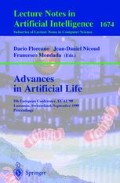Abstract
We report on a case study in the emergence of a lexicon in a group of autonomous distributed agents situated and grounded in an open environment. Because the agents are autonomous, grounded, and situated, the possible words and possible meanings are not fixed but continuously change as the agents autonomously evolve their communication system and adapt it to novel situations. The case study shows that a complex semiotic dynamics unfolds and that generalisations present in the language are due to processes outside the agent.
Access this chapter
Tax calculation will be finalised at checkout
Purchases are for personal use only
Preview
Unable to display preview. Download preview PDF.
References
Batali, J. Computational Simulations of the Emergence of Grammar. In: Hurford, J. et.al. [ed.] Approaches to the Evolution of Language: Edinburgh Univ. Press. Edinburgh, 1998.
Belpaeme, T., L. Steels and J. Van Looveren (1998) The construction and acquisition of visual categories. In: Birk, A. (ed.) Workshop on learning robots, Brighton. Springer-Verlag, Berlin.
De Boer, B. Generating vowel systems in a population of agents. In Phil Husbands and Inman Harvey, eds. Fourth European Conference on Arficial Life, Brighton, 1997. MIT Press, Cambridge, MA
Hashimoto, T. et Ikegami, T. (1996) Emergence of net-grammar in communicating agents. BioSystems 38 (1996) 1–14.
Kirby, S. Language Evolution without Natural Selection. From vocabulary to syntax in a population of learners. 2nd Evolution of Language Conference, London, 1998.
Lindgren, K. and Nordhal, M. Cooperation and Community Structure in Artificial Ecosystems. In: Langton, C. Artificial Life: an overview. MIT Press, Cambridge, MA
Oliphant, M. The dilemma of Saussurean communication. Biosystems, 1996, 37[1–2], pp 31–38.
Quine, W (1960). Word and Object. MIT Press, Cambridge, MA.
Steels, L. (1997) The synthetic modeling of language origins, Evolution of Communication Journal, 1(1): 1–34.
Steels, L. (1997) Constructing and Sharing Perceptual Distinctions. In: van Someren, M. and G. Widmer (eds.) (1997) Proceedings of the European Conference on Machine Learning. Springer-Verlag, Berlin.
Steels, L. and Kaplan, F. Stochasticity as a source of innovation in language games. In Adami, C., Belew, R., Kitano, H. and Taylor, C. [eds.] Proceedings of Artificial Life VI, Los Angeles, June 1998, MIT Press, p. 368–376.
Yanco, H. and L. Stein (1993) An Adaptive Communication Protocol for Cooperating Mobile Robots. In: Meyer, J-A, H.L. Roitblat, and S. Wilson (1993) From Animals to Animats 2. Proceedings of the Second International Conference on Simulation of Adaptive Behavior. The MIT Press, Cambridge Ma. p. 478–485.
Author information
Authors and Affiliations
Editor information
Editors and Affiliations
Rights and permissions
Copyright information
© 1999 Springer-Verlag Berlin Heidelberg
About this paper
Cite this paper
Steels, L., Kaplan, F. (1999). Collective Learning and Semiotic Dynamics. In: Floreano, D., Nicoud, JD., Mondada, F. (eds) Advances in Artificial Life. ECAL 1999. Lecture Notes in Computer Science(), vol 1674. Springer, Berlin, Heidelberg. https://doi.org/10.1007/3-540-48304-7_89
Download citation
DOI: https://doi.org/10.1007/3-540-48304-7_89
Publisher Name: Springer, Berlin, Heidelberg
Print ISBN: 978-3-540-66452-9
Online ISBN: 978-3-540-48304-5
eBook Packages: Springer Book Archive

